What Is the Culture of the Lei in Hawaii? More Than a Garland
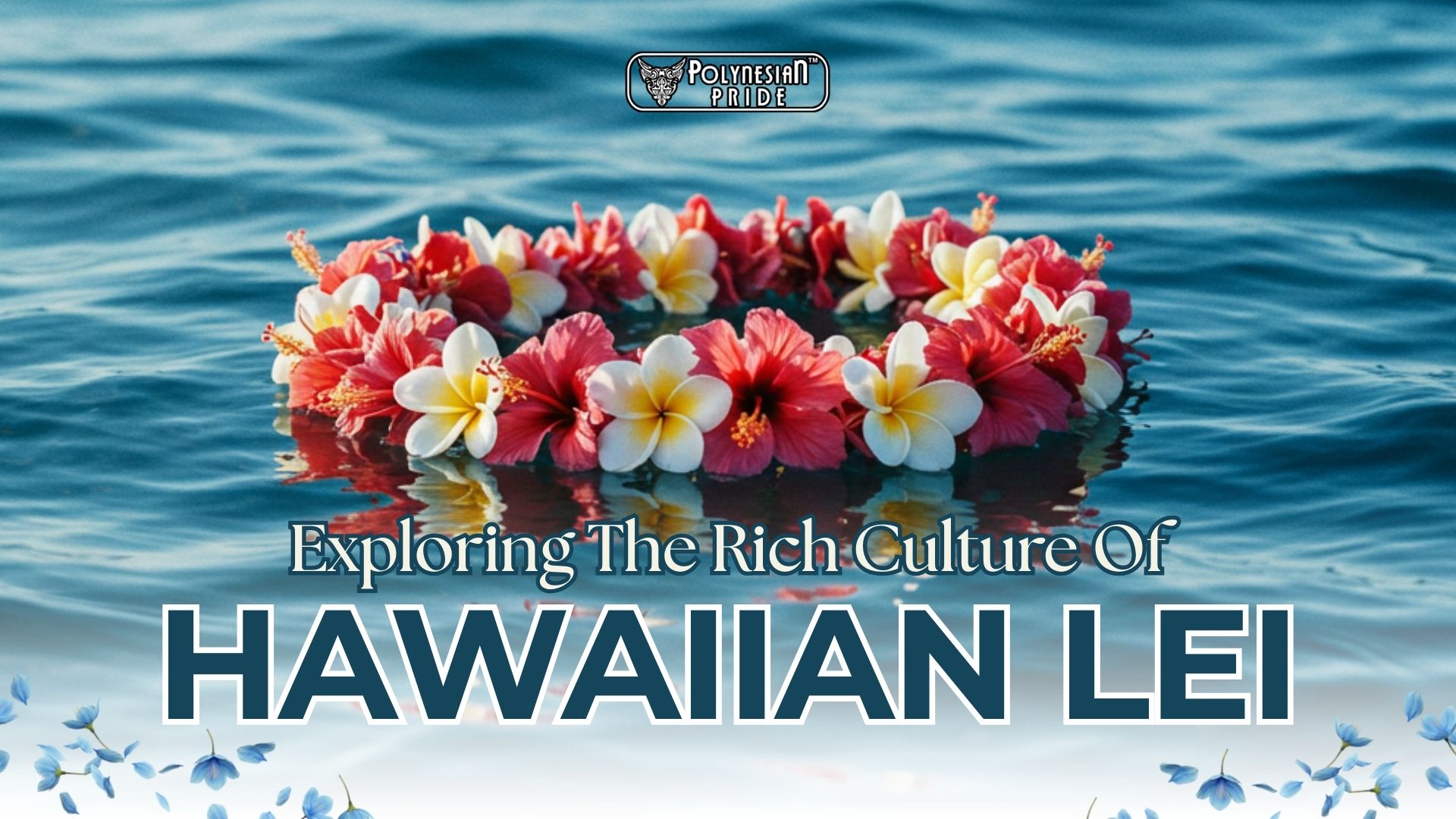
Have you ever wondered what is the culture of the lei in Hawaii and why Hawaiians have so many different kinds? This timeless tradition blends history, symbolism, and heartfelt gestures, reflecting the beauty and spirit of the islands.
Let’s dive in and discover the story behind this beautiful tradition!
1. The History of Hawaiian Lei
Lei’s Origins in Ancient Polynesia
The tradition of lei-making was introduced to Hawai‘i by early Polynesian voyagers, most likely from the Marquesas Islands and Tahiti, who arrived more than a thousand years ago.
These skilled navigators brought with them seeds, plants, and the art of lei-making, using garlands as symbols of status, affection, and spirituality.
Over time, Native Hawaiians developed this tradition into a uniquely Hawaiian practice that incorporates endemic plants on the island and refines weaving techniques that reflect local values and natural resources.
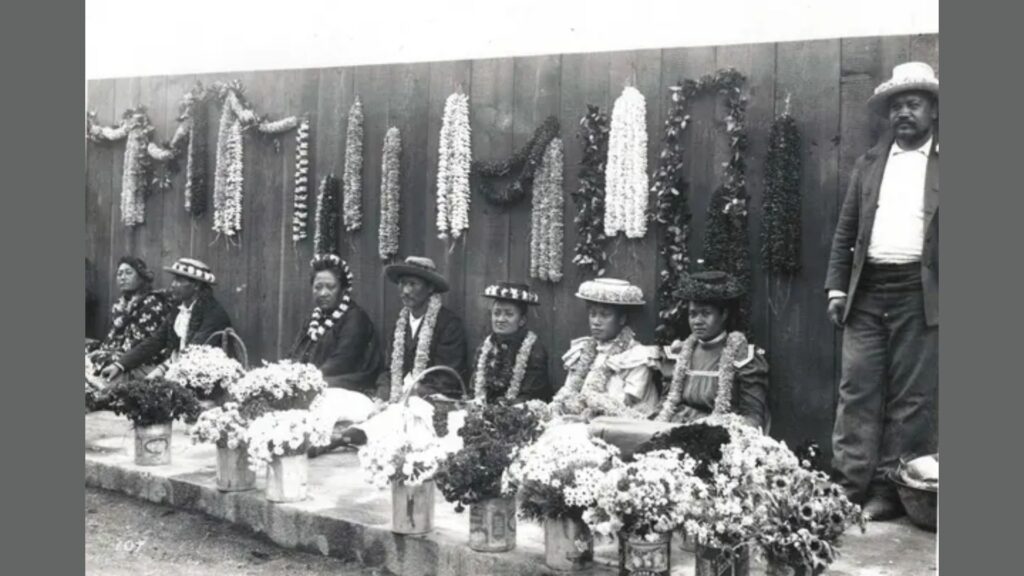
Historical Timeline of the Lei
- 1893 – Overthrow of the Hawaiian Kingdom: The power of the aliʻi (royalty) came to an end, and many royal ceremonies involving lei gradually disappeared from official public life.
- 1898 – Annexation by the United States: Native Hawaiian culture faced heavy Western influence. The lei began appearing in American-style celebrations in Hawaii, reducing its original sacred role.
- Early 20th century – Became a Tourism Symbol: The tourism industry popularized the airport lei greeting in Honolulu as a way to welcome visitors. While this made the lei famous worldwide, its traditional meaning was often simplified to that of a “souvenir gift”.
- 1970s – Hawaiian Renaissance: The cultural revival movement restored practices that used native plants and ancestral techniques, reclaiming the lei’s cultural and spiritual value.

Through centuries of change, the lei has evolved into a symbol of resilience. It bridges Hawaii’s past and present, preserving its spiritual roots while adapting to modern celebrations and cultural exchanges.
2. Symbolism and Meaning
The meaning of lei in Hawaiian culture goes far beyond its beauty. Giving a lei meaning that you are giving love, honor, friendship, and remembrance, serving as a bridge between people, nature, and spirit.
Roles of Lei in Ancient Hawaii
In early Hawaiian society, leis were far more than adornments:
- Religious offerings: Presented to deities during sacred rituals.
- Ceremonial attire: Worn by kahuna (priests) in spiritual and community events.
- Symbols of peace: Exchanged between rival chiefs to formalize peace agreements.
- Markers of status: Aliʻi wore elaborate lei hulu made from rare native bird feathers, representing divine connection and high rank.
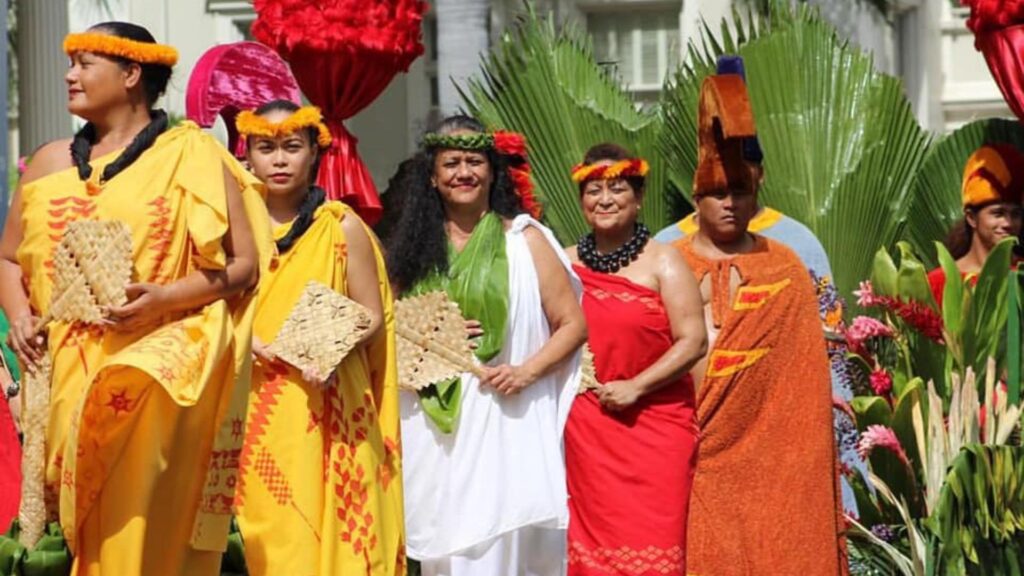
Lei Symbolism in Hawaiian Culture
- Circle of life: The lei’s circular form represents continuity, unity, and connection.
- ʻOhana: Extends beyond family by blood to include the entire community.
- Aloha spirit: Every lei is an offering of kindness, respect, and goodwill.
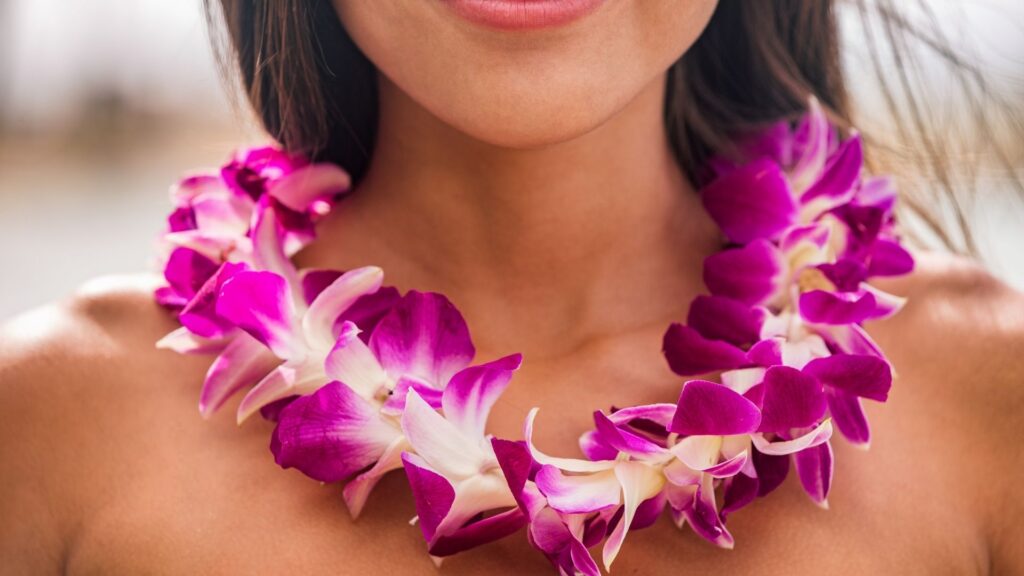
Occasions to Wear a Lei
Graduation
Leis symbolize pride, achievement, and encouragement for a new journey. Popular graduation lei ideas include incorporating ‘school colors lei’, favorite flowers, or symbolic plants into the design.
Wedding
Maile leis for grooms and white floral leis for brides represent love, respect, and unity. Couples often exchange leis as part of their vows.
Funeral & Memorial Services
Funeral leis, often made of maile leaves or white flowers, signify peace, remembrance, and eternal bonds. Sometimes, flowers loved by the departed are included for a personal touch.
Other occasions
- Birthdays & anniversaries: Celebrating milestones and personal achievements.
- Welcoming visitors: Hospitality and aloha.
- Cultural festivals: Especially Lei Day (May 1st), honoring Hawaiian heritage.
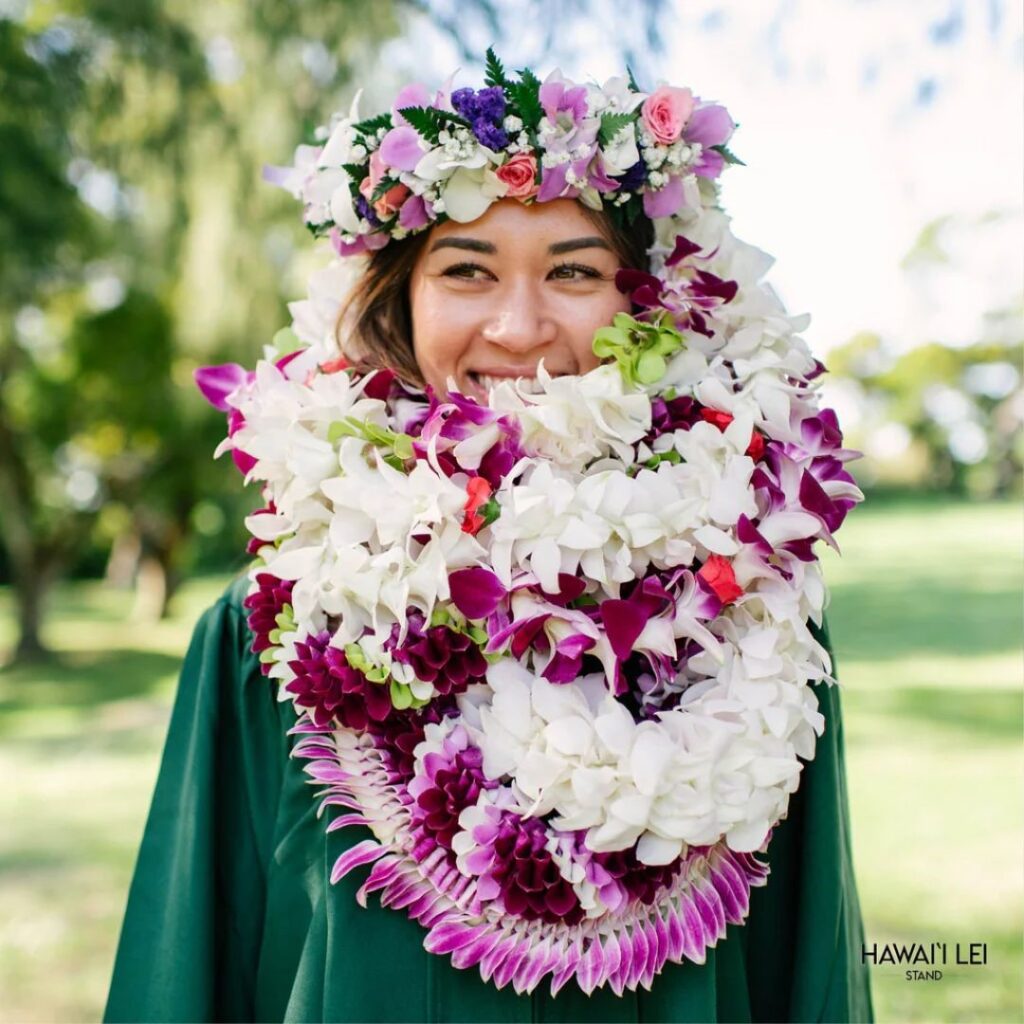
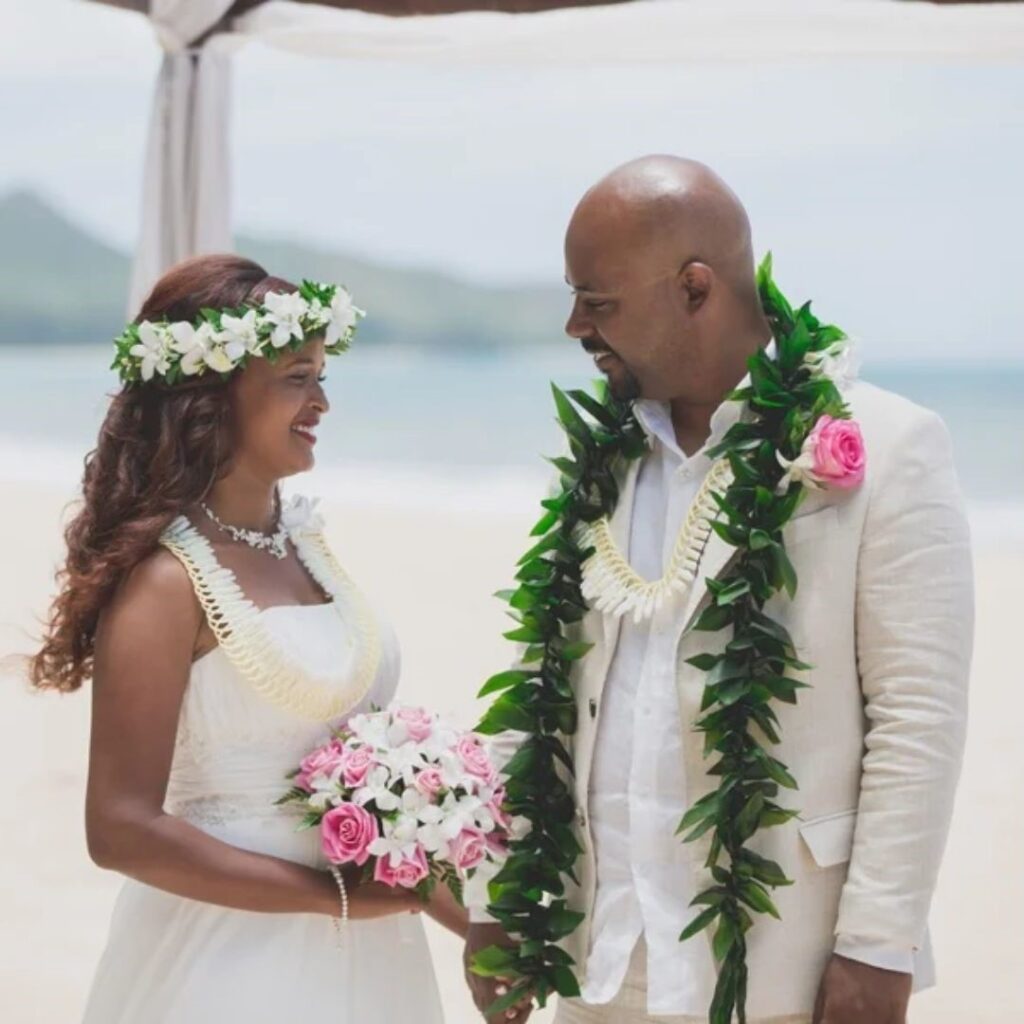
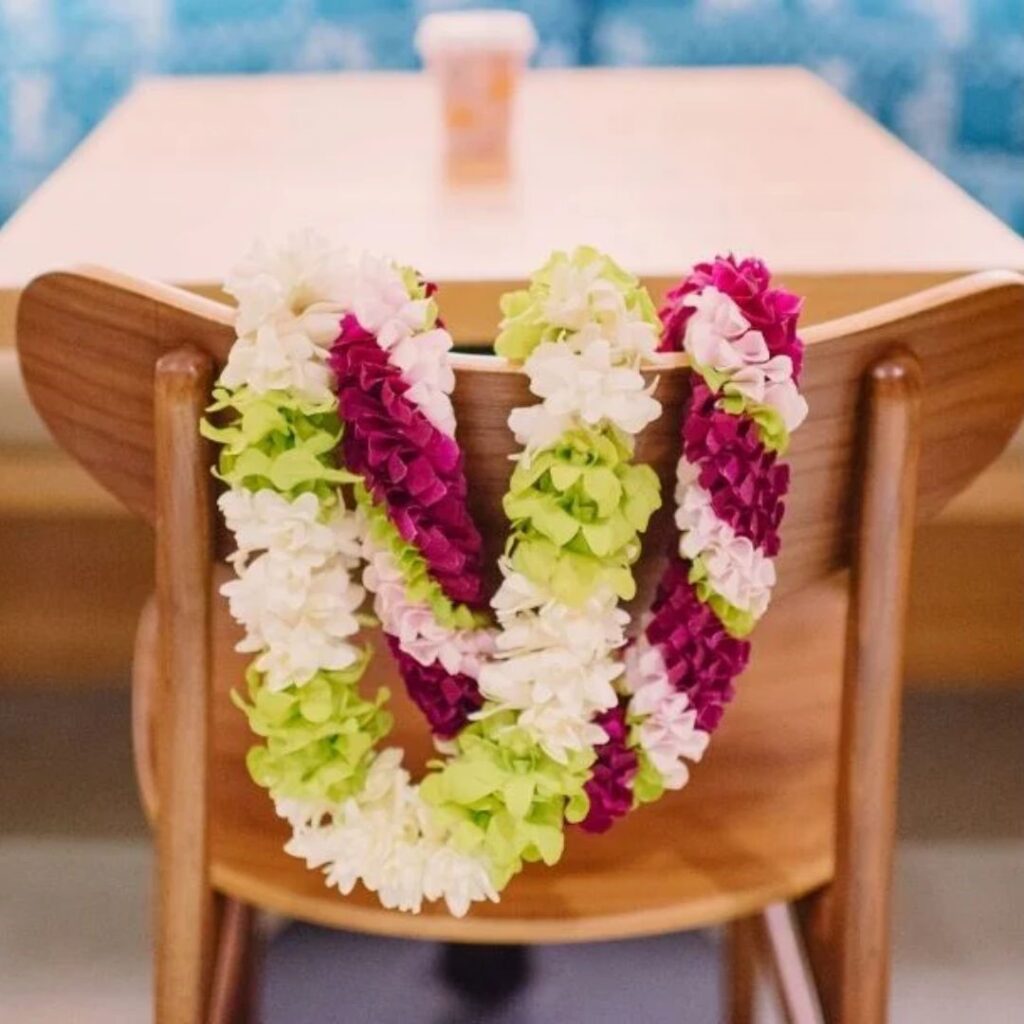
Flowers, Materials & Their Meanings by Occasion
The choice of materials in a lei is never random; each element carries symbolic meaning, often tied to the islands’ history and spiritual beliefs:
| Flower / Material | Meaning | Common Occasions |
| Mokihana berries | Subtle anise scent, symbol of Kauaʻi island | Cultural ceremonies, honoring Kauaʻi roots |
| Maile leaves | Respect, honor, peace, spirituality | Weddings, funerals, blessings |
| Orchids | Long-lasting beauty, strength, grace | Welcoming visitors, corporate events |
| Hibiscus (yellow) | Hawaii’s state symbol flower, the delicate beauty | Weddings, cultural festivals |
| Plumeria | Love, femininity, new beginnings | Birthdays, weddings, greetings |
| Pikake (jasmine) | Romantic love, elegance | Weddings, anniversaries |
| Tuberose | Intense fragrance, celebration | Weddings, graduations |
| ʻIlima (golden) | Royalty, honor, love | Ceremonial events, honoring guests |
| School colors | Pride, achievement | Graduations |
| White flowers | Purity, new beginnings | Weddings, christenings |
| Yellow flowers | Friendship, joy | Birthdays, casual celebrations |
Traditional lei-making is not only about beauty; it is an act of respect for the ʻāina (land) and ʻohana. Many artisans gather their materials mindfully, ensuring sustainability and honoring the plants they use.
3. Types of Hawaiian Lei
Hawaiian leis come in many styles, each carrying unique symbolism and serving different occasions. Understanding the types of Hawaiian lei not only enriches cultural appreciation but also helps in choosing the right lei for each event.
Neck Lei
The most common style is worn around the neck with both ends draped evenly in front. Symbolizes welcome, affection, and honor. Popular in greetings, graduations, and ceremonies.
Lei po’o vs Haku?
In Hawaiian culture, lei po‘o is a head lei, while haku refers to the braiding or weaving technique used to make it.
- Lei po‘o: A general term for any floral crown worn on the head.
- Haku: The traditional method of braiding or weaving flowers and greenery together.
A haku lei is a type of lei po‘o created using the haku technique. Not all lei po‘o are haku, as they can also be made using other methods like wili (wrapping).
Simply explain: if you see a flower crown, it’s a lei po‘o; if it’s braided or woven, it’s a haku lei.
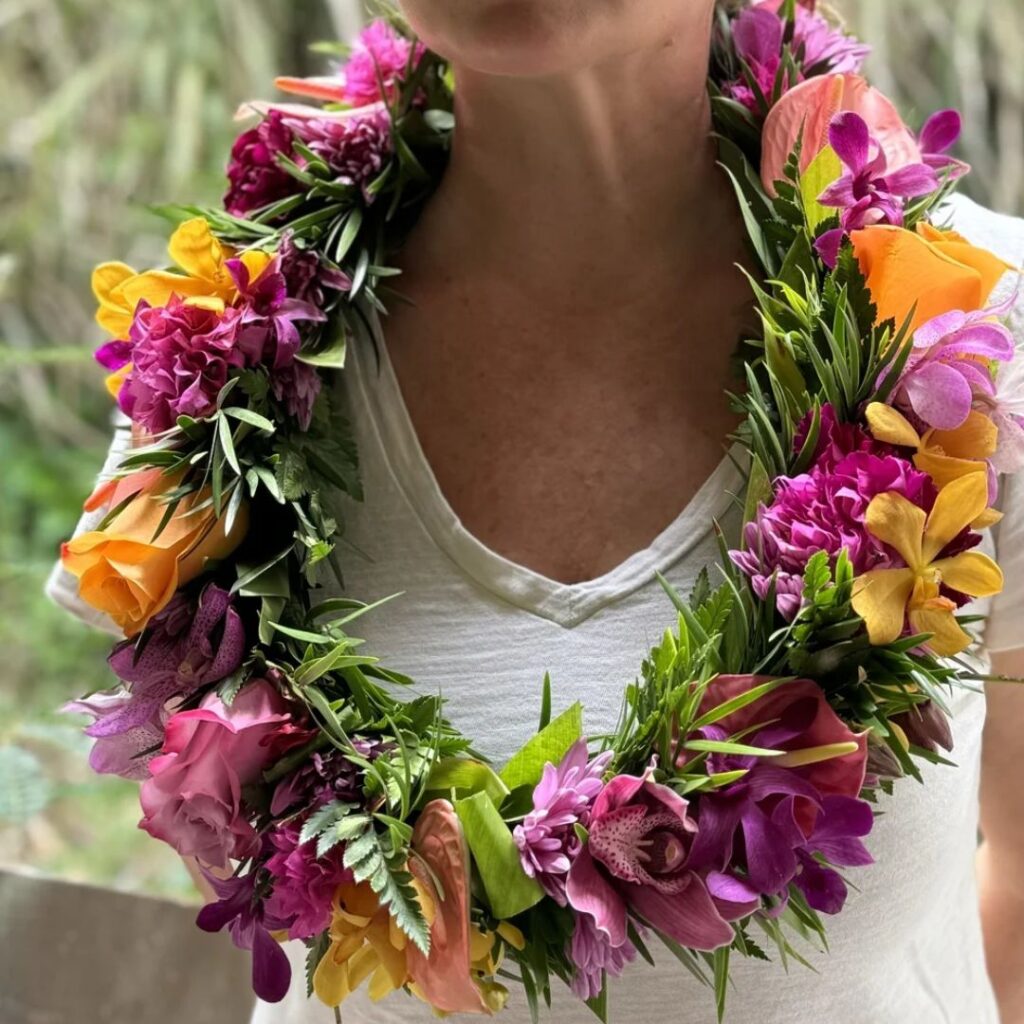
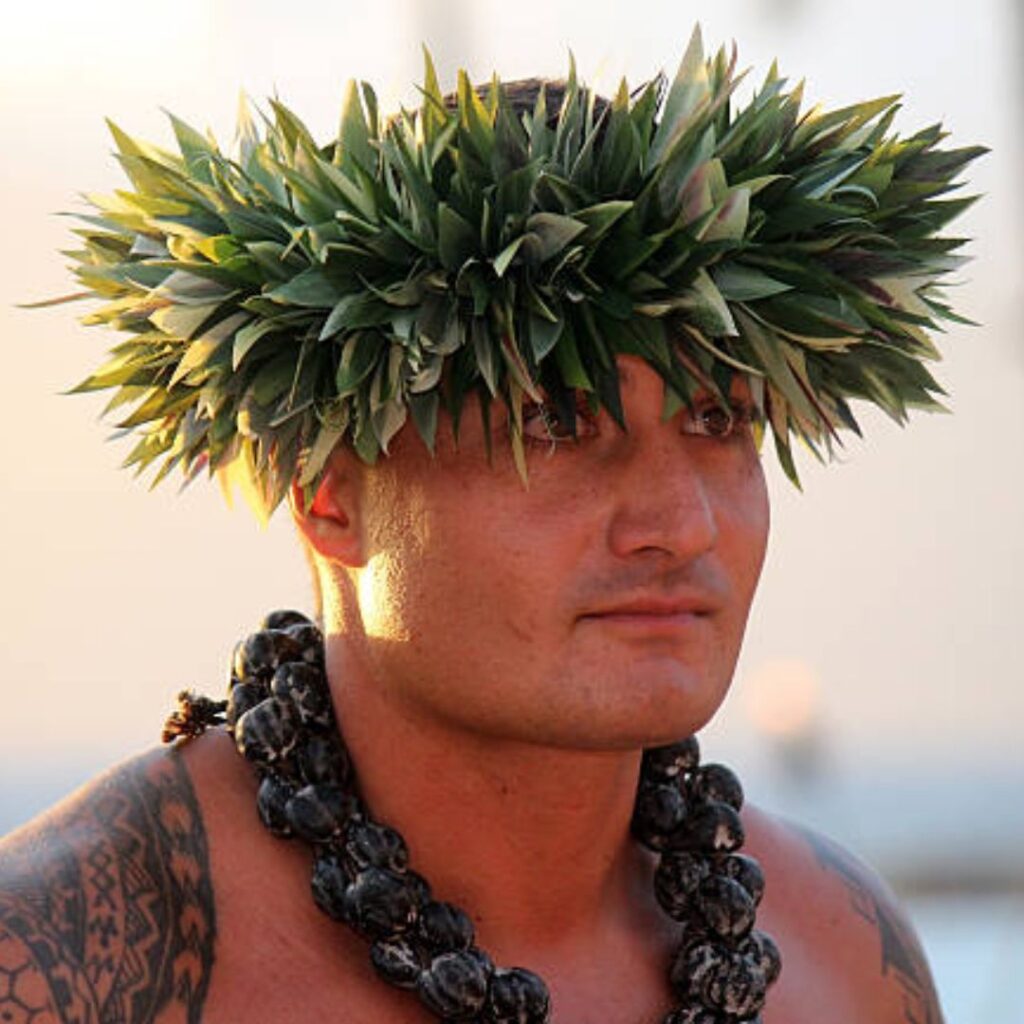
Flower Lei
In Hawaiian culture, the common choice for a flower lei often comes down to orchid lei vs plumeria lei, with orchids symbolizing elegance and longevity, while plumeria represents love, beauty, and new beginnings.
Leaf Lei
Crafted from greenery such as maile leaves, traditionally symbolizing peace, respect, and spiritual connection. Often worn at weddings and funerals.


Shell, Feather & Kukui Nut Lei
- Feather leis (lei hulu): Crafted with rare bird feathers, historically worn by Hawaiian royalty as symbols of high status and divine connection.
- Shell leis: Made from ocean shells, believed to carry blessings from the sea and often given as tokens of respect.
- Kukui nut leis: Made from the polished nuts of the candlenut tree, symbolizing enlightenment, protection, and peace. Commonly worn for both formal events and casual celebrations.
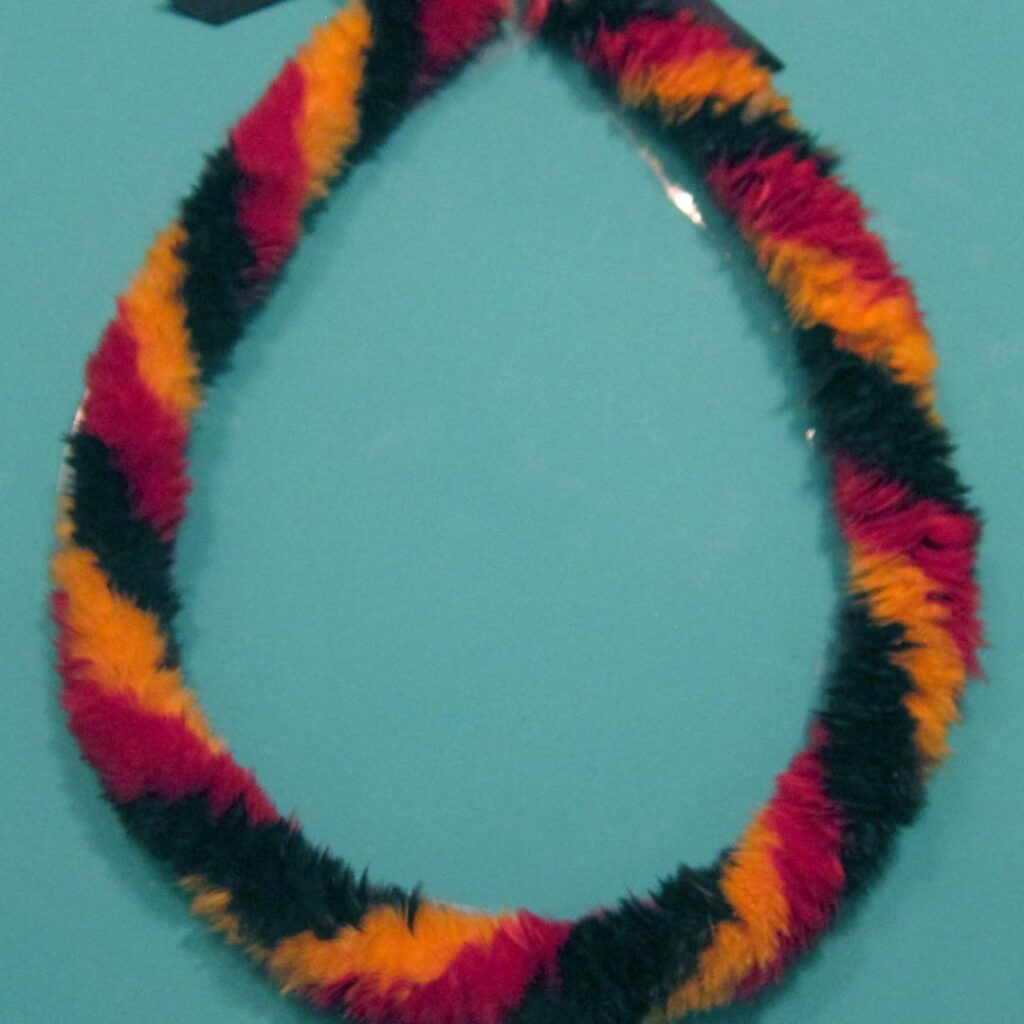
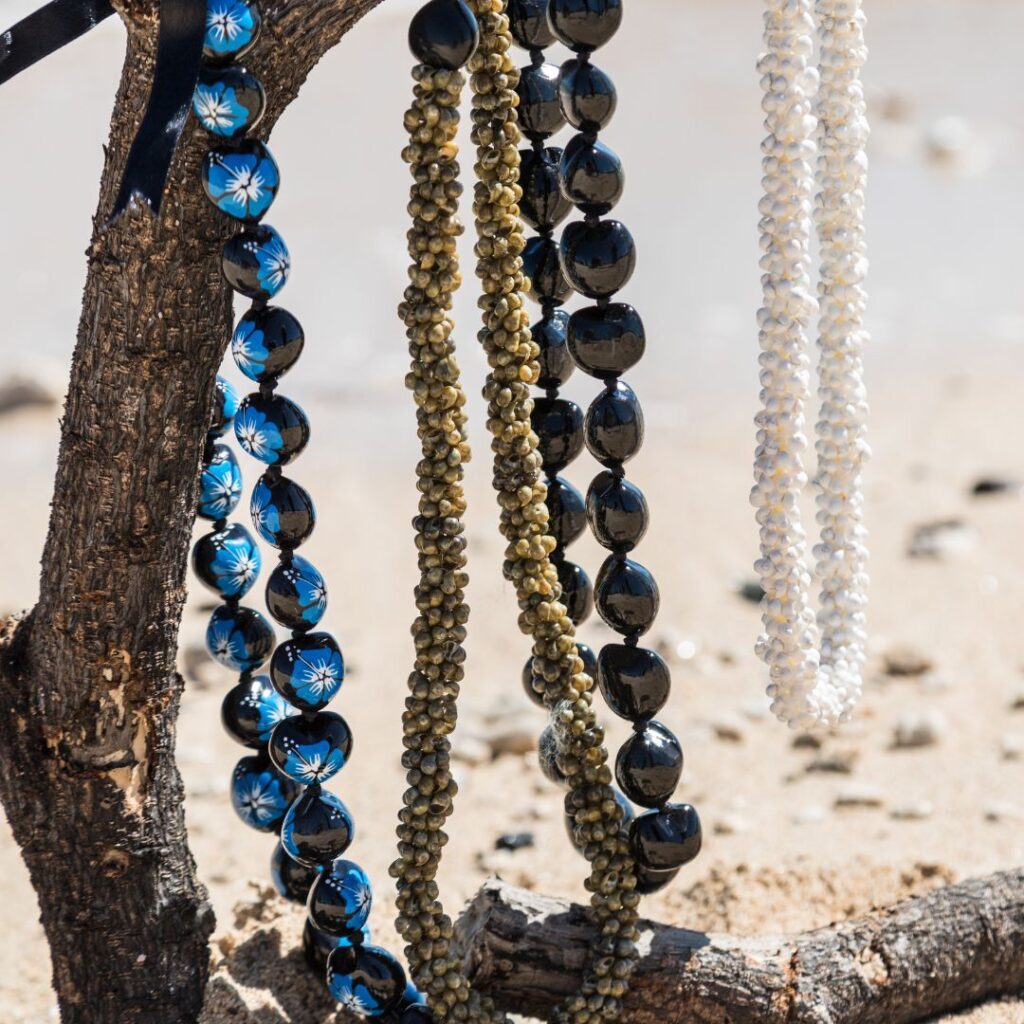
Traditional Lei-Making Techniques
Lei-making in Hawaii is a cultural practice passed down through generations, with each technique having its own style, level of complexity, and traditional use:
- Hili: Braiding strands of a single material, such as ferns or vines, to create a sleek and uniform lei. Often used for understated elegance.
- Haku: Weaving flowers, leaves, or feathers around a flexible base like softened bark or vine. This method is commonly used for haku lei po‘o.
- Kui: Piercing the center of flowers, leaves, or other materials and stringing them onto a thread or cord. This is the classic style most visitors recognize.
- Wili: Twisting flowers, leaves, and vines around a central core, creating a dense, textured lei that holds its shape well.
- Hilo: Twisting two long strands together, often using ti leaves or maile vines, producing a rope-like lei.
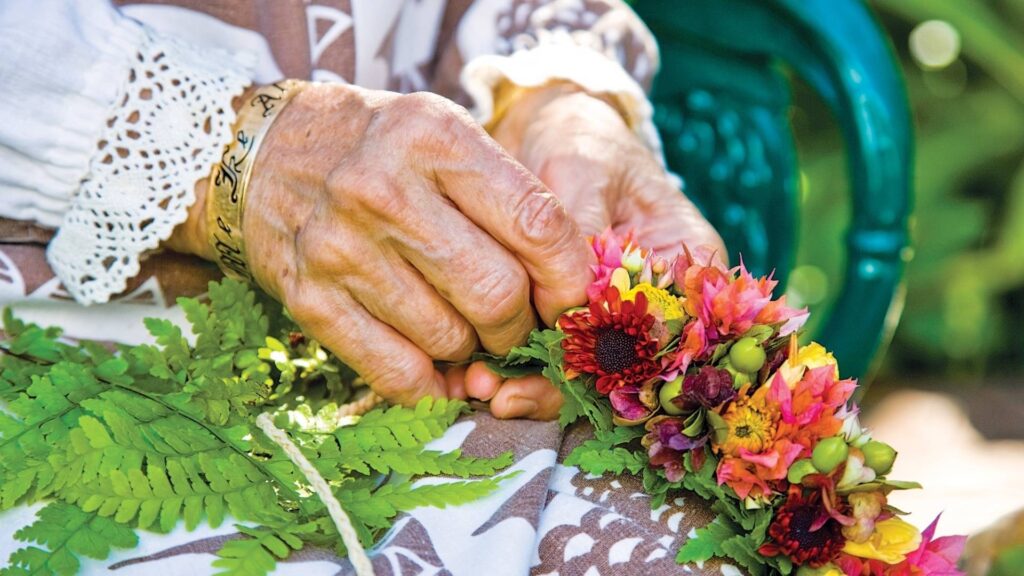
4. Lei Etiquette: Dos and Don’ts

In Hawaii, presenting or wearing a lei is more than a simple gesture. It’s a warm embrace in floral form, carrying generations of tradition. The way you wear it, accept it, and even dispose of it says a lot about your respect for Hawaiian culture.
Respect is central to Hawaiian lei etiquette. Keep these guidelines in mind to honor the tradition:
| Do ✅ | Don’t ❌ |
| Accept a lei with a smile and gratitude. | Refuse a lei in front of the giver. |
| Wear it as presented and don’t change its position. | Remove it while still with the giver. |
| Return leis to nature respectfully (hang, bury, or release into the ocean). | Throw a lei in the trash. |
| Learn the meaning of flowers before gifting. | Give a lei without knowing its symbolism. |
| Give pregnant women open-ended leis rather than closed or tied leis. They symbolize a smooth and safe path for childbirth. | Give closed leis to pregnant women (bad luck for both the mother and the unborn child). |
Extra tip: When placing a lei over someone’s head, avoid bumping their face or glasses. It should be a gentle, respectful gesture.
5. How to Make a Simple Flower Lei
After learning what a Hawaiian lei is and its meaning, you can create your lei using a simple, beginner-friendly method by following these steps:
Materials You Will Need
- 40–50 fresh flowers (orchids, plumeria, or any long-lasting bloom)
- Greenery (fern leaves or ti leaves for added texture)
- Lei needle (long, thin needle designed for lei-making)
- Cotton thread or fishing line
- Scissors
Step-by-Step Instructions
- Prepare your materials
- Remove any dirt or damaged petals.
- Cut flower stems to about ½ inch from the base.
- Thread the needle
- Tie a knot at one end of your thread or fishing line, leaving 2–3 inches of extra length for tying off.
- String the flowers (Kui method)
- Pierce through the center of each flower and slide it gently down the thread.
- Alternate flowers and greenery for variety.
- Measure the length
- Standard leis are about 40 inches (102 cm) long, but you can adjust for preference.
- Tie off the lei
- Once you’ve reached the desired length, tie the ends securely.
- Trim any excess thread.
- Store properly
- Keep in a plastic bag with light moisture and refrigerate until ready to use.
Tips for a More Authentic Lei
- Use flowers and greenery from your local area to give the lei a personal touch.
- Incorporate fragrant blooms like pikake or tuberose for a sensory experience.
- If making a lei for a specific occasion, choose flowers whose colors and meanings match the event.
6. The Lei in Modern Hawaii
Today, lei traditions Hawaii keep alive the essence of what is the culture of the lei in Hawaii: honoring the land (ʻāina), strengthening community bonds, and celebrating milestones from graduation to weddings.
Cultural Preservation & Sustainability
According to the University of Hawaiʻi’s College of Tropical Agriculture and Human Resources, some native plants traditionally used for lei, such as maile, mokihana, and certain native ferns, are now threatened due to habitat loss and overharvesting. Dedicated practitioners are working to revive them through:
- Sustainable harvesting to prevent overuse.
- Native replanting projects to restore ecosystems.
- Community education to teach younger generations traditional lei-making techniques.

These combined efforts ensure that the cultural and ecological heritage of the lei will be passed on to future generations.
Lei Day Festival Events
Every year on May 1st, Hawaii celebrates Lei Day, a statewide festival honoring the art of lei-making. The event features:
- Lei-making competitions showcase creativity and craftsmanship.
- Hula performances, Hawaiian music, and cultural storytelling.
- Workshops where visitors can learn lei ceremony traditions firsthand.
Lei Day not only preserves the practice but also deepens public understanding of its cultural roots.

Global Preservation Efforts
Nowadays, Hawaiian culture thrives far beyond the islands. One example is Hālau Kalama in Aurora, Colorado, where a cultural organization teaches hula, Hawaiian language, and lei-making. Each year, they host Denver Lei Day, connecting the Hawaiian diaspora and the local community through shared traditions.
By engaging both Hawaiians and non-Hawaiians, these initiatives keep lei symbolism and its values alive, even thousands of miles from the Pacific.
Final Thoughts
When people ask, “What is the culture of the lei in Hawaii?”, the answer goes far beyond flowers and fragrance. A lei is a timeless expression of love, respect, and unity, woven with stories that connect generations and communities.
Today, whether you wear a lei at a graduation, exchange it at a wedding, or offer it in remembrance, you are honoring a tradition that continues to inspire people across the world. Each lei is more than an adornment; it is the spirit of aloha, shared with love, and carried forward with meaning.
FAQs
Why are leis important in Hawaii?
They symbolize love, respect, and the welcoming Aloha spirit.
What does a lei symbolize?
It symbolizes an act of friendship, honor, or celebration.
How to wear a lei properly?
To wear a lei properly, drape it evenly around your neck so both ends hang in front, letting it rest naturally without tying or tucking the ends.
When should you not wear a lei?
Avoid removing it in front of the giver, and pregnant women traditionally refrain from wearing closed leis.

As an arts and traditional crafts specialist rooted in pe‘a (Samoan tatau), kapa making, and ceremonial carving, I’ve nearly 10 years of experience in fine art and its cultural significance. Experience the beauty of the traditional art of tattooing through my latest publication.
Inspire Your Style
Contact me:
Email: [email protected]
Tel: +685 77 23699






